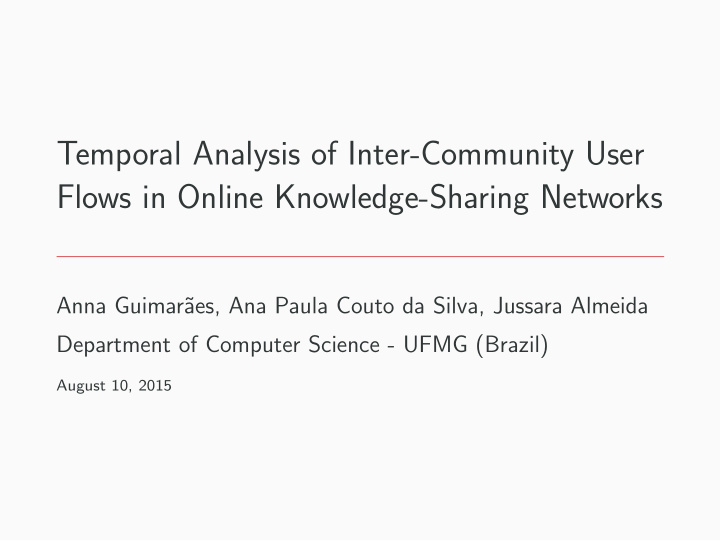



Temporal Analysis of Inter-Community User Flows in Online Knowledge-Sharing Networks Anna Guimar˜ aes, Ana Paula Couto da Silva, Jussara Almeida Department of Computer Science - UFMG (Brazil) August 10, 2015
Communities in Knowledge-Sharing Networks • Online Knowledge-Sharing Networks – Wikis, Q&A sites, discussion forums – User-created and maintained discussions – Wealth of knowledge! 2
Communities in Knowledge-Sharing Networks • More than repositories for knowledge – Community structure surrounding discussions – Multiple topics, multiple communities 3
Communities in Knowledge-Sharing Networks • More than repositories for knowledge – Community structure surrounding discussions – Multiple topics, multiple communities • This study: – Communities in knowledge-sharing networks 3
Communities in Knowledge-Sharing Networks • More than repositories for knowledge – Community structure surrounding discussions – Multiple topics, multiple communities • This study: – Communities in knowledge-sharing networks – Inter-community relationships according to user dynamics 3
Communities in Knowledge-Sharing Networks • More than repositories for knowledge – Community structure surrounding discussions – Multiple topics, multiple communities • This study: – Communities in knowledge-sharing networks – Inter-community relationships according to user dynamics – Temporal evolution of inter-community relationships 3
Communities in Knowledge-Sharing Networks • Communities centered around topics – Topics are explicity defined – Independent from social interaction graph • Non-exclusive membership to multiple communities 4
Topic-Based Communities in Stack Overflow 5
Topic-Based Communities in Stack Overflow Tags 5
Stack Overflow Dataset • User activity – User ID, Tag ID, Time stamp • Data covering a six-year period – 2008–2014 Dataset Tags Posts Users Top-100 100 15.4 million 1.2 million Top-400 400 19.8 million 1.7 million 6
Inter-Community User Flows • How to measure the relationship between two communities? 7
Inter-Community User Flows • How to measure the relationship between two communities? – Tag hierarchy 7
Inter-Community User Flows • How to measure the relationship between two communities? – Tag hierarchy – Semantic similarity of keywords 7
Inter-Community User Flows • How to measure the relationship between two communities? – Tag hierarchy – Semantic similarity of keywords – User dynamics 7
Inter-Community User Flows • How to measure the relationship between two communities? – Tag hierarchy – Semantic similarity of keywords – User dynamics • Flow of users between communities: flow c 1 , c 2 ( t ) = | C 2 ( t ) ∩ C 1 ( t − 1) | | C 1 ( t − 1) | 7
Inter-Community User Flows: Findings • Pravelence of lower flow values – flow c 1 , c 2 > 0 . 20 for 25% and 10% of all community pairs 8
Inter-Community User Flows: Findings • Pravelence of lower flow values – flow c 1 , c 2 > 0 . 20 for 25% and 10% of all community pairs • Increasing number of low flow values over time – flow c 1 , c 2 (2014) > 0 . 14 for 22% and 10% of all community pairs Mean Flow Value Dataset 2008 2014 Top-100 0.21 0.08 Top-400 0.14 0.05 8
Inter-Community User Flows: Findings • Pravelence of lower flow values – flow c 1 , c 2 > 0 . 20 for 25% and 10% of all community pairs • Increasing number of low flow values over time – flow c 1 , c 2 (2014) > 0 . 14 for 22% and 10% of all community pairs • Greater variability of flow values over time Mean Coefficient of Variation Dataset 2008 2014 Top-100 0.73 1.23 Top-400 0.87 1.27 8
Flow Evolution: CSS to Javascript 0.75 CSS JS 0.55 2008 9
Flow Evolution: CSS to Javascript 0.75 0.76 CSS JS CSS JS 0.55 0.55 2008 2014 9
Flow Evolution: Flash to HTML 0.43 Flash HTML 0.12 2009 10
Flow Evolution: Flash to HTML 0.43 0.29 Flash HTML Flash HTML 0.12 0.03 2009 2014 10
Flow Evolution: Active Record to Ruby on Rails 0.61 AR Rails 3 0.25 2010 11
Flow Evolution: Active Record to Ruby on Rails 0.61 0.41 AR Rails 3 AR Rails 0.25 0.26 2010 2014 11
Flow Evolution: Active Record to Ruby on Rails 0.61 0.41 AR Rails 3 AR Rails 0.25 0.26 0.45 0.28 2010 2014 Rails 4 11
Macro-Communities • Increasingly well-defined inter-community relationships • Groups of communities with high inter-community flows – Determined by user dynamics instead of semantic analysis • Clique Percolation Method applied over community graph – Communities as nodes and user flows as edge weights – Top 10% edges with highest flow values – Community overlap 12
Macro-Communities Programming Apple Java iOS Windows windows 13
Macro-Communities • Small number of macro-communities – Popular communities connected to several satellite communities – e.g., Java connected to 88 communities in the Top-100 set • Topical cohesion – General programming, Windows-related technologies, Apple- related technologies, Ruby on Rails technologies, programming IDEs and extensions 14
Evolution of Macro-Communities • Changes to macro-community structure over time: Top-100 Top-400 #Communities in Clusters #Communities in Clusters 80 400 70 350 60 300 50 250 40 200 30 150 20 100 10 50 0 0 2008 2009 2010 2011 2012 2013 2008 2009 2010 2011 2012 2013 Years Years 15
Evolution of Macro-Communities • Single, dominant macro-community – Present at every time window – Covers a majority of the communities – General, more popular topics • Fragmented macro-communities converge over time • Recurring core of communities • Variable community composition – Macro-communities may feature a different subset of communities in each time period 16
Conclusions • Knowledge-sharing networks as a dynamics multi-community network • Inter-community relationships as a function of their members – Different evolution patterns for community relationships • Discovery of macro-communities – User flows 17
Thank you! Anna Guimar˜ aes anna@dcc.ufmg.br 18
Recommend
More recommend